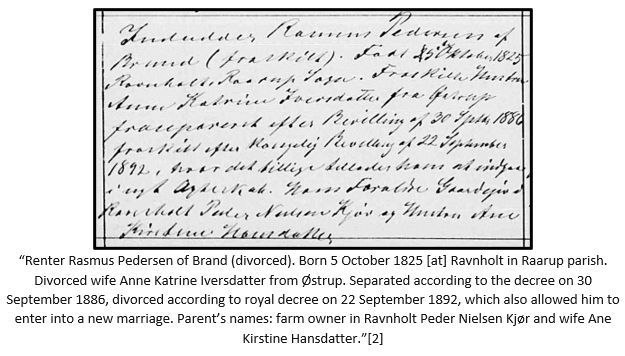Danish Research Part 3 : How to Know They are Yours
 23
23Apr

Have you ever looked at a Danish record or record index and wondered if the person in the record was actually your ancestor or one of the dozen others of the same name who lived in the same area? In Denmark, like other countries, tradition led parents to reuse family and popular names. Initially, this is no big deal, but since Denmark tended to have less variety in given names and Danish surnames followed the patronymic pattern, people tracing Danish genealogy have some work cut out for them sorting through many John Smith-like names. This Danish research post will walk you through several examples and give suggestions on how to find your specific ancestor with confidence.
Danish Research Part 3: How to Know They're Yours
Patronymics and Common Names
For many centuries, Scandinavian surnames worked differently than the rest of the Western world. When a child was born, they would be given a name like Lars or Marie Johanne. Unlike today, they did not inherit the last name of their father. Instead, they took a version of their father’s first name. If the father of Lars was Eric Olsen, then Lars’ last name would be Ericsen (the son of Eric). If Marie Johanne was the daughter of Peder Sorensen, then she would be Marie Johanne Pedersdatter (the daughter of Peder).
When this patronymic naming pattern is combined with common Danish names like Lars, Peder, Johan, or Ole, this makes for multiple generations and multiple families with the same exact names being used over and over. Eventually, some Danes took formal surnames based on their occupation or residence. If you are descended from one of those individuals, you are fortunate.
Example
In the 1880 Denmark Census, a search for men named Rasmus Pedersen in the county of Præstø revealed over 30 men all called Rasmus Pedersen who were born in the 1840s and 1850s. If looking for an ancestor named Rasmus Pedersen from Præstø, then it could be difficult to sift him out from all the others.
Strategies
Here are some strategies for tackling a situation where there are multiple men or women with the same names:
- Pay attention to the dates.
- Pay attention to the relationships.
- Pay attention to the places.
- Look at the whole life.
Pay Attention to the Dates
Look for exact dates when possible. Starting in 1901, the Danish censuses recorded the full birthdate for each person. Even though many people share the same name, it is not common for someone with the same name to share the exact same birthdate, even in Denmark. For this reason, it is important to try to find a record with your ancestors birthdate. While birth and christening records are the primary place to find an exact date of birth, the latter part of the 1800s saw some parishes also record exact birth dates in records of marriages and deaths. See this marriage record as an example.

In this marriage record, the priest essentially wrote down the groom’s entire history. They wrote his birthdate, his parents, and his marriage history. After looking at this marriage record, it would likely be obvious if this was the right Rasmus Pedersen or not, because all of the unique dates in his life were presented in one record.
Note that in earlier records, the priests may not have recorded conventional dates like we are familiar with. Instead, they might have written it as a feast day. These dates were based on the church calendar year rather than the Gregorian and Julian Calendar years that we are used to. For example, maybe there are three people with the same name born in the same year. While there are dates in the record, they are written like “6te søndag efter Helligtrekongersdag” or sixth Sunday after Three King’s Day. Luckily, the FamilySearch Wiki has a guide to those tricky Danish feast days. Look up the article titled “Denmark Feast Day Calendars,” to learn more about Feast Days or to calculate the feast day in a record to a more recognizable date.[3]
Example Problem
In the earlier example of 30+ Rasmus Pedersen’s in Præstø, the first step might be to search for those Rasmus Pedersen’s in the 1901 Denmark census to find an exact date of birth. This would uniquely differentiate them from each other and make it easier to identify a particular one among them.
Sometimes Dates Are Not The Answer
In earlier time periods, there may only be one record that gives a particular exact date. For example, the exact birthdate may not be recorded anywhere else other than the birth and christening record. In that case, matching dates may not be as helpful. If there are five Peder Larsens, all born the same year in the same place, it would be impossible to find a birth record for them by just looking at the date.
Pay Attention to Relationships
A unique relationship can help you differentiate between people who appear to match in every other way. While the odds are great that there will be multiple men or women of the same name as your ancestor, the odds are less that they will all have a spouse of the same name. Fortunately in Denmark, women did not have to change their last name to match their husband until the 1900s. This means that records may give the full maiden name of the wife. Marie Olsdatter would stay Marie Olsdatter in the records even after marrying.
Next time you are trying to tell the difference between five Peder Larsens, look at the spouses, children, or other family.
Example Problem
In some situations, looking at the dates and relationships may not be helpful for solving the problem. Take this situation for example:
An index on Ancestry.com says that, in 1814, Ane Pedersdatter married Hans Jensen in Gentofte parish, Copenhagen, Denmark.[4] Unfortunately the index does not give any more info than that. Later records in Ane’s life suggest that she was born 1790-1792, but her parents were not known (other than that her father’s name must have been Peder based on her last name). The Ancestry.com index for Denmark births was not very helpful, because there were three Ane Pedersdatters born in Gentofte parish between 1790 and 1792.
Ancestry Results

How can you find out which of these birth and christening records belongs to the Ane Pedersdatter who married Hans Jensen?
Pay Attention to the Place
One of the most important factors to consider when matching a record to a person is the geography. When sorting out people of the same name, it is critical to pay attention to the place names. In Denmark, the local geographical unit was the church parish. In rural Denmark, a church parish would consist of a number of towns and farms. In urban areas of Denmark, a large city might contain several parishes which covered different parts of the city. When dates and relationships cannot solve the problem, paying attention to the individual farm, village, and even street where a person lived usually does the trick. See how it works with the problem above.
Example Problem
To figure out which birth record belonged to Ane, wife of Hans Jensen, the actual marriage and birth records had to be looked up.

The key information in the marriage record was that Ane Pedersdatter came from the farm Hulegaard. Now, look at the three birth/christening records:



Only one of the three birth records was for an Ane who was born while her parents were living at Huulegaard. This connection suggests that the correct parents for Ane, wife of Hans Jensen, were Peder Larsen and Maren Pedersdatter. An additional step might have been to manually search the birth and christening records of Gentofte to be sure there were no other matches for Ane. Regardless, without paying attention to the actual farm names, it would be extremely difficult to figure out Ane’s parents.
To get help with place names, go again to the FamilySearch wiki for Denmark. Denmark has its own page for each parish in the country and has helpful maps for the country and each county.[12]
Warning
All of the major tree-building websites give hints or recommendations for Danish records. It is important to evaluate each record based on dates, relationships, and geography. If one of those things does not match up, particularly geography, take a step back and evaluate if the record is a true match or if the tree-building website’s hint got it wrong.
Conclusion
It is normal in Danish genealogical research to encounter many people with the same name, around the same time, in the same area. For beginners and even veterans, this can lead to mistakes in the family tree. By closely examining dates, relationships, and places, any confusion as to whether a record matches is usually cleared up. Use the FamilySearch wiki to learn about the geographical places, the unique date format, and naming patterns of Denmark. Approach Danish record hints with care.
By Forrest
Sources:
[1] Image from https://pixabay.com/illustrations/hand-magnifying-glass-earth-globe-1248053/.
[2] Skjolde parish, Vejle county, Denmark, “Kirkebøger, 1688-1914,” Copulerede 1892-1909, v. 3, p. 235, entry for Rasmus Pedersen and Jette Madssen, married 26 October 1892; image, FamilySearch (https://www.familysearch.org/ark:/61903/3:1:3QSQ-G94D-J99Z-2?i=443&cc=2078555 : accessed 21 April 2021); FHL microfilm 423729.
[3] “Denmark Feast Day Calendars,” FamilySearch Wiki (https://www.familysearch.org/wiki/en/Denmark_Feast_Day_Calendars : accessed 21 April 2021), last edited 19 February 2021.
[4] “Denmark Marriages, 1631-1900s,” database, Ancestry (https://ancestry.com : accessed 21 April 2021), entry for Ane Pedersdr and Hans Jensen, married 14 October 1814; citing Genealogical Society of Utah, Western Europe Vital Records Index (Salt Lake City: Intellectual Reserve, 2000).
[5] “Denmark, Births and Christenings Index, 1631-1900s,” database, Ancestry (https://ancestry.com : accessed 21 April 2021), entry for Ane, christened 14 Nov 1790 in Gentofte, Kobenhavn, Denmark; citing Genealogical Society of Utah, Western Europe Vital Records Index (Salt Lake City: Intellectual Reserve, 2000).
[6] “Denmark, Births and Christenings Index, 1631-1900s,” database, Ancestry (https://ancestry.com : accessed 21 April 2021), entry for Ane, christened 9 October 1791 in Gentofte, Kobenhavn, Denmark; citing Genealogical Society of Utah, Western Europe Vital Records Index (Salt Lake City: Intellectual Reserve, 2000).
[7] “Denmark, Births and Christenings Index, 1631-1900s,” database, Ancestry (https://ancestry.com : accessed 21 April 2021), entry for Anne, christened 15 July 1792 in Gentofte, Kobenhavn, Denmark; citing Genealogical Society of Utah, Western Europe Vital Records Index (Salt Lake City: Intellectual Reserve, 2000).
[8] Gentofte parish, Copenhagen, Denmark, “Enesteministeralbog 1651-1814,” 1651 FKVD - 1814 FKVD, image 404 of 429, p. 230, entry for Hans Jensen and Ane Pedersdtr, christened 14 October 1814; image, Arkivalieronline (https://www.sa.dk/ao-soegesider/da/billedviser?epid=17114977#150191,24885470 : accessed 21 April 2021).
[9] Gentofte parish, Copenhagen, Denmark, “Enesteministeralbog 1651-1814,” 1651 FKVD - 1814 FKVD, image 315 of 429, p. 54, entry for Ane, christened 14 November 1790; image, Arkivalieronline (https://www.sa.dk/ao-soegesider/da/billedviser?epid=17114977#150191,24885381 : accessed 21 April 2021).
[10] Gentofte parish, Copenhagen, Denmark, “Enesteministeralbog 1651-1814,” 1651 FKVD - 1814 FKVD, image 318 of 429, p. 60, entry for Ane, christened 9 October 1791; image, Arkivalieronline (https://www.sa.dk/ao-soegesider/da/billedviser?epid=17114977#150191,24885384 : accessed 21 April 2021).
[11] Gentofte parish, Copenhagen, Denmark, “Enesteministeralbog 1651-1814,” 1651 FKVD - 1814 FKVD, image 321 of 429, p. 66, entry for Anne, christened15 July 1792; image, Arkivalieronline (https://www.sa.dk/ao-soegesider/da/billedviser?epid=17114977#150191,24885387 : accessed 21 April 2021).
[12] “Denmark Genealogy,” FamilySearch Wiki ()https://www.familysearch.org/wiki/en/Denmark_Genealogy : accessed 21 April 2021), last edited 16 March 2021.
Have you ever done any Danish research? Let us know in a comment below!
